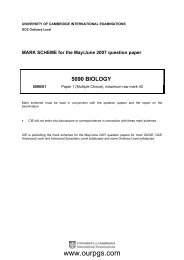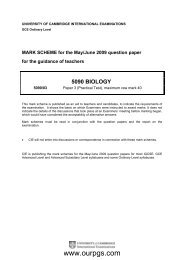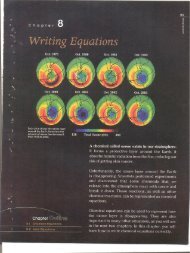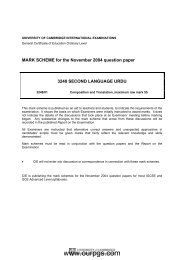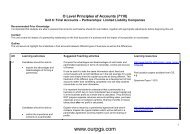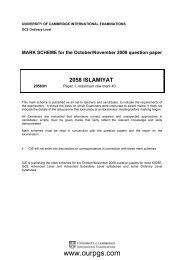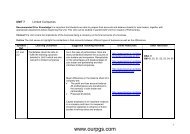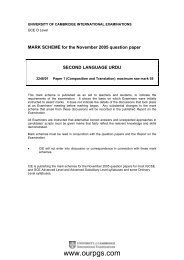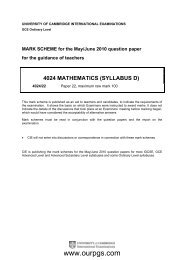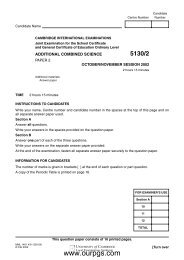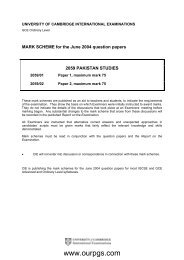IGCSE Computer Studies-Syllabus 09.pdf - Ourpgs.com
IGCSE Computer Studies-Syllabus 09.pdf - Ourpgs.com
IGCSE Computer Studies-Syllabus 09.pdf - Ourpgs.com
- No tags were found...
You also want an ePaper? Increase the reach of your titles
YUMPU automatically turns print PDFs into web optimized ePapers that Google loves.
COMPUTER STUDIES 0420 <strong>IGCSE</strong> 2009CURRICULUM CONTENTThis syllabus must be read as an integrated whole and not as a progression. The sectionsoverlap and interrelate and the order of the sections reflects a top-down view of thesubject: a study of the applications of <strong>com</strong>puters and the effects of their use is supportedby a study of the design processes, methods and mechanisms which underlie suchapplications.The sections of the syllabus follow:1 Applications of <strong>com</strong>puters and their social and economic implications.2 System analysis.3 Problem solution, including algorithm design and programming concepts.4 Generic software and the organisation of data.5 Hardware, systems and <strong>com</strong>munication.Each syllabus section contains a number of subsections, and there are aims described for eachsection and objectives for each subsection. The content is presented in a two-column format, withtopics listed on the left and notes on the topics on the right. Some topics have no notes whilesome others have extended notes. The absence, brevity or length of the notes is notintended to imply weighting to be given to the topic. It is more to do with whether or not thereare suitable, widely available sources of clear and unambiguous information on the topicelsewhere. Where terms are defined in the notes, the definitions are for the purposes of thesyllabus; they are not necessarily universal definitions.It is not the role of an examination syllabus to lay down how a course is to be organised.However, a suggestion of a possible course structure may be helpful; the following should not beviewed as prescriptive.It is anticipated that a successful course based on this syllabus could start with a study of a simpleapplication, including topics from throughout the syllabus which relate to that application, and thatthis pattern could be repeated with applications from a variety of areas and of increasing<strong>com</strong>plexity. Within this overall structure there would need to be some periods when particulartopics in the syllabus were studied in more detail, but, as far as possible, any topics would bestudied in the context of their application. In parallel with these studies there would be practicalwork designed to build upon and illustrate the applications and topics being studied.When a problem is considered that may be solved using <strong>com</strong>puters, the problem must first beanalysed to establish the desired out<strong>com</strong>e and the information requirements. This is followed bythe design of a suitable overall system. The parts of the system and the interactions between theparts then need to be specified in detail and an appropriate form of solution selected for each ofthese parts. In order to implement the solutions effectively, suitable data organisations, algorithms,software and hardware <strong>com</strong>ponents need to be chosen, and appropriate tools and techniquesused. Some understanding of the underlying system software and architecture assists in thesensible and efficient uses of resources in the implementation of solutions.5www.ourpgs.<strong>com</strong>



